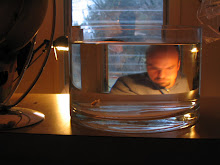Yesterday morning, with a handsome fall day stretched before her like a sail, Cleo opted to kick things off with a return to the classics. She chose, that is, to watch 25 minutes of Beauty and the Beast, which was one of her favorite videos back in the spring, but which had since given way, in her video rankings, to more alternative and more surreal offerings (like the episode of Magic Schoolbus in which the kids take their bus into the throat of a sick Ralph). Anyway, as she watched in a warm pair of inherited ballet-themed pajamas, Belle's small village took shape before us, and Belle began all over again to chafe at the associated limitations of life outside the city. Sure, she has her local library, and, sure, her dad is a lovable inventor - but, still, there are times when a girl wants something more, well, cosmopolitan. Or, as Belle puts it in a song that Cleo then echoed minutes later while gliding through the dining room, "There must be more than this provincial life!"
And, indeed, there is. The opening section of the movie was over by 7:45, and the rest of the day still lay before us. So: what can one find to do on a Sunday in a city of 600,000? Quite a lot, it turns out. The first order of the day was a sunlit table outside a cafe, where Cleo painted and L. and I actually got to read some of the Sunday Times. A few games of Crazy Eights and dominoes acted as an interlude, before we drove to the Walters, where Cleo manufactured a Japanese-inspired book binding and then toured the early medieval section with me, before posing for this photo:
Next, it was on to the city's book festival, where she hand-colored a Wonder Woman mask, and then to Druid Hill park, where she and I gamboled, played keep-away with two balls, and eventually met up with her classmate Jasper, for some impromptu narratives involving a princess, a knight, and two large swords.
Soon enough, it was 6:00, and the sky was beginning to look slightly like the peachy vault behind Belle, above. So we packed up, drove home, and met Mom, who'd taken in a play and attended a book club meeting. In time, we would watch another section of Belle's story. But for a time, I thought that our day had functioned as a neat embodiment of Belle's own aspirations. The city provides, on many levels, a respite to ennui. And we who live in it can thus only fantasize about characters who wish for much broader horizons.

.JPG)









